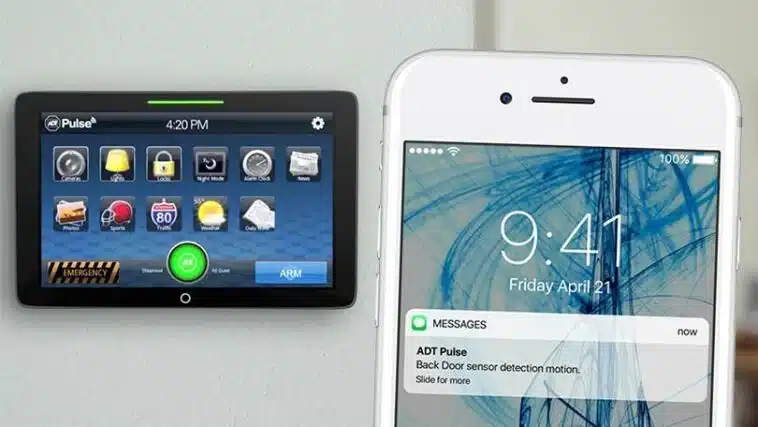How often do you ask someone for their landline number? It seems like such an ancient practice, right?
The number of households using landlines is steadily falling. But what does it imply for landline home security systems? Can they be installed without a landline?
Since we often encounter this question about ADT security systems, we decided to investigate and address this hot topic. Let’s see whether or not ADT security systems require a landline.

Does ADT Security System Require Landline to Keep a Household Safe?
No, ADT doesn’t require a landline to keep you safe. You may have an ADT security system without a landline.
Only 40% of Americans have a landline, so ADT has developed advanced technologies, including cellular and wireless software, to monitor and transmit signals without needing a phone line.
Let’s review all the options they offer in detail.
Landline ADT Security System
A landline protection system connects to the ADT monitoring center through your home phone line. Such systems include:
- ADT Basic
- ADT Total Protection
- ADT Total Protection Plus
Here’s how an ADT landline security functions.
When an alarm goes off, ADT uses your home phone line to call the monitoring station. If you’re speaking on your house phone while the alarm goes off, the security system will automatically take over the connection and dial the ADT monitoring station. Once notified, the security system opens the line so that you may talk with an ADT agent.
Pros & Cons
A landline ADT security system is a more affordable and reliable option than wireless and cellular ADT security systems.
In fact, a landline system is the least expensive choice. It’s also less vulnerable to signal interference from nearby radio towers, mobile devices, and bad weather.
However, there are certain flaws in landline networks. For instance, if the landline is cut either by someone or due to poor weather, the alarm will stop working.
A robber who knows you have a landline ADT security system only needs a pair of scissors to cut off its signal, disable your security system, and enter your home.
Plus, landlines deliver warnings slower than other networks since the signal must travel over miles of landline cables. Typically, it takes up to 30 seconds for home security systems to call and reach out to a monitoring center when sending a signal via a landline.
Cellular & Wireless ADT Security Systems
Home phones are merely gathering dust in our houses these days since most people communicate through their mobile devices. So the ADT wireless systems take advantage of this fact to secure your surroundings through cutting-edge cellular and wireless technology. These include:
- Blue by ADT
- ADT Pulse
- ADT CellGuard
These landline-free systems don’t require an existing phone line in your house. Instead, they communicate via radio waves and Wi-Fi to monitor and send signals to the ADT monitoring centers.
Pros & Cons
Wireless and cellular connections are becoming increasingly common because of their extreme versatility, safety, and efficiency. They’re frequently used in conjunction with one another to offer many levels of protection!
Installing these security systems is straightforward — there’s no need for demolition work, wires, or drilling holes, meaning they are more convenient than traditional landline security systems.
Since they don’t have cables, relocating them around the house or into a new home is simpler.
The possibility of accidental or intentional wire damage won’t be an issue with a cellular or wireless security system. Since there are no wires to break, a thief won’t be able to cut your phone connection and enter your house.
These security systems integrate and function more effectively with other smart home gadgets. They also sync with the ADT smartphone app that offers additional options for you, like arming or disarming alarms, monitoring through cameras, checking if a camera is offline, and notifying you in case of a false alert.
Speaking of signal transmission speed, signals through cellular security systems are transmitted faster than signals received via a landline. While a landline can take up to 30 seconds to connect to the ADT monitoring center, cellular and wireless systems send signals instantly. Thirty seconds matter a lot in life-and-death situations!
The cost of cellular and wireless security systems is higher than that of landline security systems, which brings us to their disadvantages. If you decide to use this innovative technology, be prepared for higher monthly costs.
Additionally, radio towers, mobile devices, and severe weather conditions can cause signal interference for cellular and wireless signals. As a result, they typically have more frequent signal problems than traditional landline lines.
Security systems that use wireless and cellular communications depend on a power supply. Many of these devices feature rechargeable batteries, which can provide extended security for no longer than a day or two in the event of a power outage.
That’s why you must ensure that the batteries are charged and functional. If your ADT batteries reach the end of their lifespan, you will need to replace them with new ones. Otherwise, in case of a power outage, you won’t have any power supply to keep your security system up and running.
Landline or No Landline? Breaking Down the Pros & Cons of ADT Security Systems
| ADT Landline Security System | ADT Wireless & Cellular Security System |
|---|---|
| Connects to the ADT monitoring center through a home phone line | Communicate via radio waves and Wi-Fi to monitor and send signals to the ADT monitoring center |
| Pros | Pros |
| Less expensive Less vulnerable to signal interference More reliable | Frequently used in conjunction for higher levels of protection Straightforward installation Relocating them is much simpler Lower chances of a burglar breaking in since there are no wires to cut Transmitting much faster signals to the monitoring center, only 6 seconds Integrating and functioning effectively with other smart home gadgets; Connected to a smartphone app |
| Cons | Cons |
| Prone to wire breakage that might cause the entire shutdown of a security system Time-consuming installation Prone to break-ins, since a robber only needs a pair of scissors to cut off the signal and enter the home The signal must travel over miles of landline cables Delivers warnings more slowly, around 26 seconds | More expensive Less reliable due to its vulnerability to signal interference Very dependent on a power supply The rechargeable batteries can’t provide security for more than a day or two If the batteries aren’t charged and maintained, there won’t be any any power supply to keep your security system up and running in case of a power outage |

Can ADT Cellular or Wireless Security Systems Be Hacked?
While some people know how to hack wireless and cellular networks, this occurs very rarely, if ever.
The FBI doesn’t even keep track of break-ins involving hackers since they happen so infrequently. In fact, according to the FBI’s 2019 crime report, forced or unlawful entry was used in 90% of burglaries, while 6.5% of the remaining 10% included unsuccessful forced entry attempts.
Conclusion
Using an ADT security system is still feasible without a phone, and as the chart above illustrates, having wireless or cellular security may be more practical.
The question is, which one do you favor: landline-based ADT or wireless and cellular network-based ADT?
If you want a budget-friendly option less vulnerable to signal interference, go with a landline ADT security system.
Cellular and wireless ADT security systems are more pricey. However, they offer faster signal transmission, easy installation, remote access, a mobile app, and many other qualities.
After weighing the advantages and disadvantages of each, cellular and wireless ADT systems come on top as the superior security option. However, we’ll let you make the final choice. Are you ready to reevaluate your security system choices, or do you want to stick to the good old landline option?